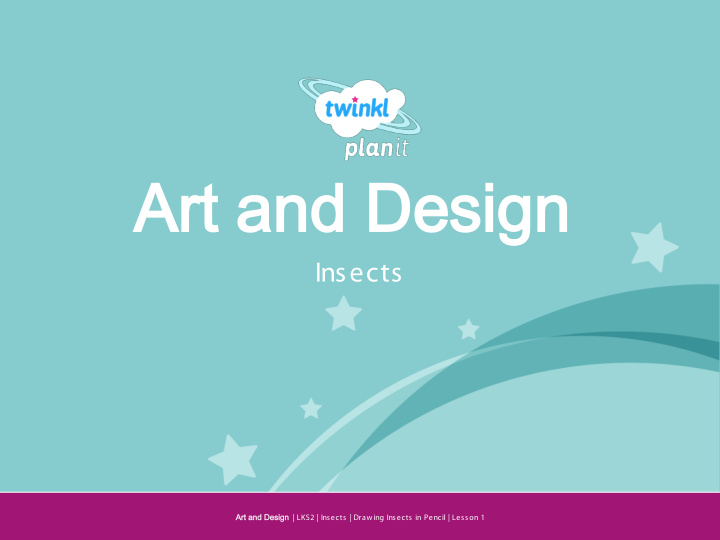



Art and Design Art and Design Insects Year One Art and Design Art and Design | LKS2 | Insects | Drawing Insects in Pencil | Lesson 1
D r aw i n g I n s ec t s i n P en ci l
Aim Aim • I can draw an insect in pencil. • I can use my sketchbook. Success Criteria Success Criteria • I can draw details showing that I have looked many times at the photograph. • I can draw a thorax, abdomen and head in my insect. • I can look back at my drawings and discuss my ideas. • I can record a drawing in my sketchbook.
Looking at Insect Art Looking at Insect Art
Insect Art Insect Art Look at your image . What can you see in the photograph? Which colours are used? When was it made? What is it made of? Why do you think the artist made it? What kinds of insects can you see in the painting? How does the image make you feel? Which of the artworks you have seen today would you have in your home? Why?
Dawn and Twilight (1901) Dawn and Twilight (1901) by Emile Galle Photo courtesy of Jean -Pierre Dalb é ra (@flickr.com) – granted under creative commons licence - attribution
A Swallowtail, a Red Admiral and Other A Swallowtail, a Red Admiral and Other Insects with Shells and a Sprig of Borage (1659) Insects with Shells and a Sprig of Borage (1659) by Jan van Kessel the Elder Photo courtesy of Swallowtail Garden Seeds (@flickr.com) – granted under creative commons licence - attribution
Grasshopper Grasshopper by Edouard Martinet Photo courtesy of sladmore.com
Ecofauna Ecofauna by Lorenzo Possenti Photo courtesy of ecofauna.com
Mutated Bugs Mutated Bugs by Cornelia Hesse -Honegger Photo courtesy of angs school (@flickr.com) – granted under creative commons licence - attribution
Looking at Insects Looking at Insects All insects have 3 body Split your plasticine into I n s ec t P a i r parts: thorax, abdomen three balls to create and F a c t 1 A c t i v i t y 1 Each body part can be a and head. then join each part. different size depending on the insect – some I n s ec t insects have bigger F a c t 2 heads, others have Alter one of the three bigger thoraxes etc. P a i r I n s ec t plasticine balls to make All insects have six legs. A c t i v i t y 2 F a c t 3 your insect different. P a i r I n s ec t Thread pipe cleaners for the legs. Some have antennae and wings. A c t i v i t y 3 F a c t 4
Looking at Insects: Looking at Insects: Discussion Points Discussion Points Discuss the two questions with a partner and then share. • What does this information mean for spiders? • Which animals in these photographs are actually insects?
What a good What a good insect drawing insect drawing looks like… looks like…
Visible and Invisible Visible and Invisible Differences Differences Look at the insects on this page. On whiteboards, write 3 differences that are visible (can be seen). Then write 3 invisible (cannot be seen) differences between the insects.
Aim Aim • I can draw an insect in pencil. • I can use my sketchbook. Success Criteria Success Criteria • I can draw details showing that I have looked many times at the photograph. • I can draw a thorax, abdomen and head in my insect. • I can look back at my drawings and discuss my ideas. • I can record a drawing in my sketchbook.
Recommend
More recommend